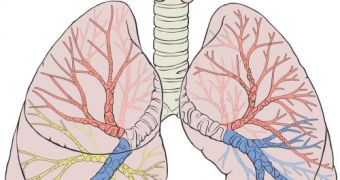Researchers at the Case Western Reserve University (CWRU) announce the creation of a fully-artificial lung, which is nearly as effective as the real deal. Unlike similar devices, this one collects the chemicals it requires from air, and not from pure oxygen supplies.
Such a medical instrument has the potential to save thousands of lives each single year, provided people can afford it, and researchers can find a way of allowing it to endure the harsh conditions of the human body.
Global statistics estimate that more than 200 million people suffer from lung disease around the world. Artificial lungs could for example be used as a means of allowing lung cancer patients to survive.
As soon as experts would determine that the tumor is untreatable, the patient would have their lungs replaced with an artificial one. This approach could help prevent countless useless deaths.
CWRU research assistant professor in electrical engineering and computer science Joe Potkay coordinated this research. He is also the lead author of a new paper describing the findings, which is published in the latest issue of the scientific journal Lab on a Chip.
“Based on current device performance, we estimate that a unit that could be used in humans would be about 6 inches by 6 inches by 4 inches tall, or about the volume of the human lung,” the team leader explains.
“In addition, the device could be driven by the heart and would not require a mechanical pump,” Potkay goes on to say. He adds that human blood vessels are emulated through the use of breathable silicone rubber “veins,” some of which are extremely small and narrow.
The most important thing about this new approach is that the artificial lung is portable, does not require an external power source, and does not require carrying heavy tanks of pure oxygen around. Conceivably, the new system could have a long lifespan as well.
CWRU researchers admit that their system is a few years away from practical applications, but say that it will almost definitely reach the market. At this point, experts expect clinical trials to begin within a decade or so.

 14 DAY TRIAL //
14 DAY TRIAL //